PinotFile: 12.13 January 17, 2021
|
2018 Vintage Willamette Valley Pinot Noir 👍
 Despite the warm growing season, there were few heat spikes with no heat stress as in 2017. Low rainfall in September and October permitted winemakers to harvest grapes when desired. The Oregon Wine Board noted, “When moderately warm days occur along with cool nights, vines can rest in the evening and concentrate efforts on developing more fruit complexity and flavors. Ideal conditions like this occurred throughout October in 2018. Harvest was at a leisurely pace and resulting sugar levels, acidity and pH were all close to average. Production was up around 15% over 2017. Wildfires burned in southern Oregon in July and eastern Washington in August but no smoke taint was observed in the Willamette Valley. The view of Stewart Boedecker of Boedecker Cellars sums up the vintage: “Even measured in the context of a string of great vintages, 2018 wines stand out as pretty phenomenal.” My tasting notes on Willamette Valley Pinot Noir from the 2018 vintage are in complete agreement. The three featured wineries in this issue offer Pinot Noir from estate vineyards. Dion Vineyard and Lenné Estate source their Pinot Noir wines solely from their estate vineyard, while Broadley Vineyards adds a few sourced vineyard offerings in addition to its estate bottlings. Dion Vineyard, located in the Chehalem Mountains just south of greater Portland, is the most northerly Willamette Valley site among the three vineyards. Lenné Estate is situated more southerly in the Yamhill-Carlton AVA west of Newberg in Yamhill. Broadley Vineyards is in the southern Willamette Valley in the town of Monroe midway between Corvallis and Eugene and possessing the warmest climate of the three estates. Refer to the map of the Willamette Valley below. The three wineries are presented in this issue in an order based on their northern to southern locations.
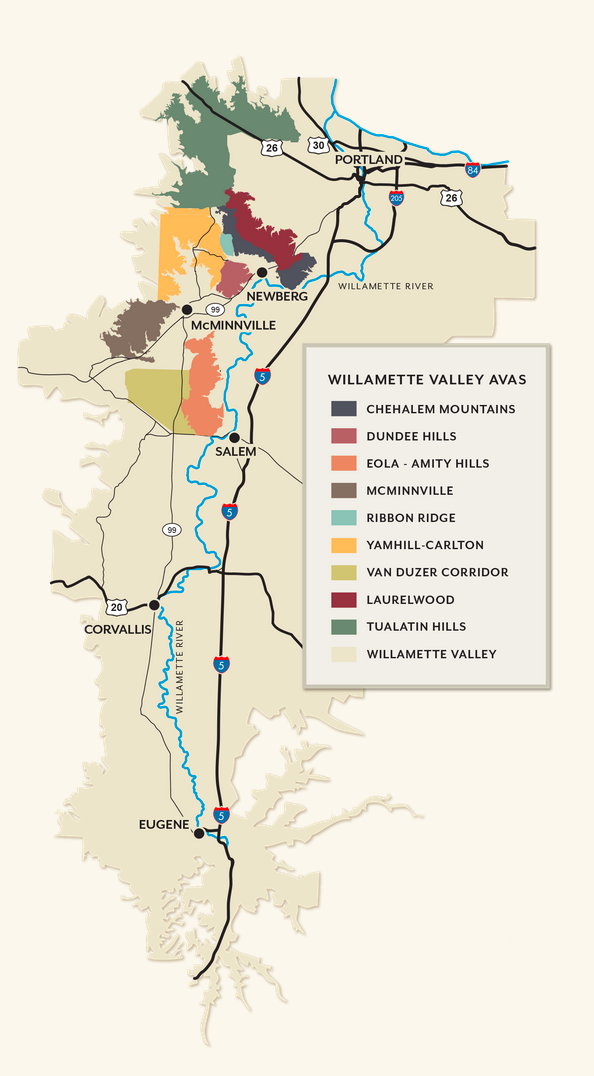
DION Vineyard
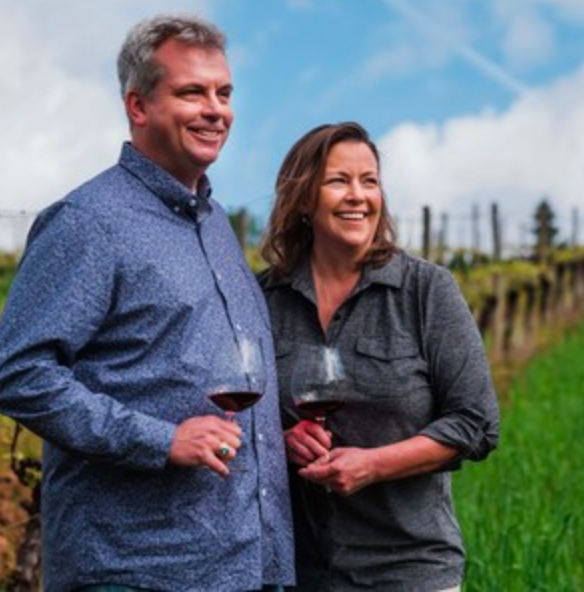 The Dion Vineyard label was launched in 2007 and current production is about 1,000 cases per year. Premium wine grapes are also supplied to other Willamette Valley wineries. The small production wines produced under the Dion Vineyard label are available to Wine Club members and through the website store at www.dionvineyard.com. I have been a fan of Dion Vineyard wines since I began reviewing the winery’s offerings in 2009. The Limited Release Old Vines Pinot Noir is an exceptional wine and a real Oregon treasure. You won’t see Dion Vineyard wines reviewed in the major wine publications and the winery’s small production does not warrant a significant marketing budget, but believe me, the Pinot Noir wines are in the upper echelon of Oregon offerings. Kevin notes, “2018 will be remembered as hitting a sweet spot for Oregon vintages.” The year had plenty of heat but was not overly hot. There was low disease pressure, and a dry fall allowing harvest to progress at optimal picking times. For Dion Vineyard, acidities were higher and sugar levels were lower (but decisively ripe) than the hotter 2017 vintage. The result was some grace as a compliment to the power of these wines.
2018 Dion Vineyard Chehalem Mountains Pinot Noir 13.8% alc., 304 cases, $32, screw cap. Released spring 2020 to wine club and fall to general public. Clones 115, 114, 667, 777 and Pommard, all from Dion Vineyard. Vines between 17 and 42 years of age. Harvest Brix 23.6º-24.5º. Aged 11 months in French oak barrels, 18% new. · Moderately light garnet color in the glass. Giving perfume upon opening with aromas of red cherry hard candy, red rose petal and a hint of spice. A very pleasing, forward-drinking wine offering middleweight flavors of red and black cherry supported by easygoing tannins and juicy acidity. Excellent harmony, with a compliment of oak in the background and some finishing length. A solid, well-priced, everyday Pinot. Score: 91
2018 Dion Vineyard 115 West Limited Release Chehalem Mountains Pinot Noir 13.5% alc., 50 cases, $45. Released fall 2020 to wine club and to the general public pending. Clone 115 from the western-most block of Dion Vineyard. These grapes traditionally anchor the winery’s Winemaker’s Reserve. Harvest Brix 23.6º-24.5º. Vines were 18 years old. Aged 14 months in French oak barrels, 50% new. · Moderately light garnet color in the glass. Engaging aromas of dark cherry, cola, cardamom spice and a compliment of oak. The black cherry core saturates the palate yet the wine is lithe and streamlined. Added accents of baking spice and licorice provide interest. There is a subtle thread of oak in the background and a touch of tannin on the juicy, cherry-fueled finish. A complete single clone wine. Score: 93
2018 Dion Vineyard Winemaker’s Reserve Limited Release Chehalem Mountains Pinot Noir 13.9% alc., 101 cases, $50. Released fall 2020 to wine club members and to the general public pending. A barrel selection from the best blocks that are most expressive of the vintage when combined. Clones 115, 114, 667 and 777 from Dion Vineyard. Age of vines was between 17 and 18 years. Aged 14 months in French oak barrels, 50% new. · Moderate garnet color in the glass. The nose is similar to the 115 West bottling featuring aromas of black cherry, sarsaparilla and spice. An exceptional wine upon opening in a mid-weight style, showing perfectlyripened black cherry fruit anointed with luscious spice. Suave and polished in the mouth, with submerged tannins and a notable finish filled with black cherry goodness. Score: 94
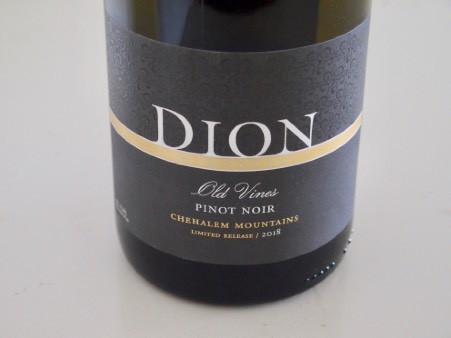 2018 Dion Vineyard Old Vines Reserve Release Chehalem Mountains Pinot Noir 13.8% alc., 92 cases, $65. 100% Pommard clone planted in 1976 on a 10-acre winery block. Selfrooted and non-irrigated. Harvest Brix 23.7º-24.1º. Aged 14 months in French oak barrels, 50% new. · Moderately dark garnet color in the glass. Intriguing aromas of darker berry and cherry, sweet pipe smoke, earthy flora and a subtle cloak of oak. Midweight plus in style with black cherry and black raspberry flavors with a rustic, gamy bent. Admirable harmony with a perfect fruit/ tannin ratio. This wine had me staring at the glass and asking, “How could so much flavor come from that wine?” The finish, like all great wines, lingered for what seemed like an eternity. When tasted the following day from a previously opened and recorked bottle, I summed up the experience as “Wow!” Decant or cellar five years to gain the full experience. Score: 96
Lenné Estate
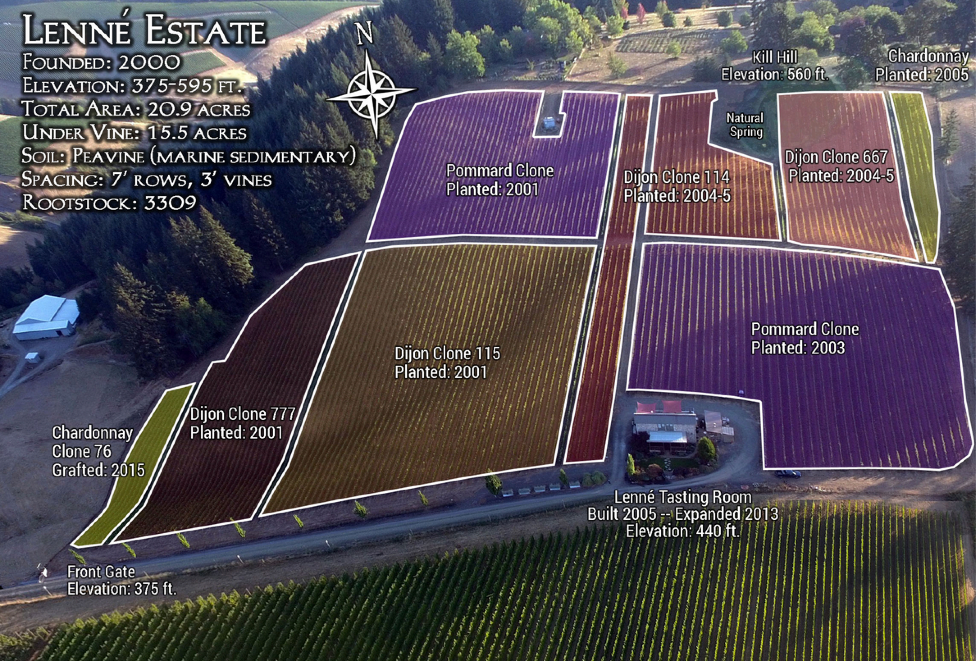 The name, Lenné, sounds French but is derived from proprietor and winemaker Steve Lutz’s father-in-law, Len, who raised his family on a chicken farm west of London, England. Len passed away in 1999 but he contributed a portion of the down payment on the vineyard so the name and the label’s distinctive profile pays homage to him. The first two vintages were released under the LeNez label (also pronounced ‘Lenay’) and in 2006 the Lenné Estate label was added. The LeNez bottling is a blend of clones from the vineyard that reflect the vineyard’s terroir, while the wines under the Lenné Estate label represent the best barrels from the vineyard in each vintage. Early on, Steve struck up a relationship with noted Oregon vintner David O’Reilly and he became the consulting winemaker initially. In 2018, the consultant winemaker was veteran Drew Voit. The style is restrained and seductive with at most 30% new French oak during elevage. I have been reviewing wines from Lenné Estate since 2006 and tasted alongside Steve multiple times. The wines definitely speak to me and I have consistently awarded the wines scores of 90 and above with many scores in the 94 range. Steve told me the 2018 wines are on the opulent side with plenty of well-ripened, darker red and black fruits and my tasting confirmed his impression. Tannins are evident but measured to the fruit load and predict age ability. Oak integration is spot on and the silken textures are attractive. Steve recommends drinking these wines 6 to 10 years from the vintage date. I would agree, as the wines are a bit reclusive at this stage. However, if you want to try them now, I would recommend the Estate or South Slope Select bottling. Lenné Estate Pinot Noir is sold on the winery’s website at www.leneeestate.com. Members of the winery’s wine club enjoy invitations to special events including Steve’s Blind Tastings.The Blind Tastings held at Lenné Estate are unique for the Willamette Valley. Usually, 4 to 6 blind tastings are held annually and feature a double-blind tasting of 8 wines. The reveal is done by Lenné’s Steve Lutz. The tastings include lunch and are open to the public. The tasting room is located at the vineyard (check for availability of tastings during COVID-19).
2018 Lenné Estate Estate Yamhill-Carlton Willamette Valley Pinot Noir 14.1% alc., pH 3.80, TA 0.59, 298 cases, $40. Released 9/1/20. Grapes 100% de-stemmed, 5-day cold soak before inoculation. Aged 11 months in French oak barrels, 33% new. The winery’s flagship bottling crafted from all five clones found in the Estate Vineyard with always at least 50% Pommard clone. · Moderate garnet color in the glass. Dreamy aromas of exuberant black cherry and cardamom spice. An approachable mid-weight style offering flavors of black cherry and dark berries with hints of spice, cola and mocha. Excellent harmony with silken tannins and generous fruit on the finish. Still easy to like when tasted the following day from a previously opened bottle. Score: 93
2018 Lenné Estate Jill’s 115 Yamhill-Carlton Willamette Valley Pinot Noir 14.1% alc., 60 cases, $55. Named after Steve’s wife’s mother. · Moderately dark garnet color in the glass. The nose is rather reclusive, even when the wine was sampled the following day from a previously opened bottle. There are hints of dark berry and mocha aromas. A charming mid-weight core of black raspberry, boysenberry and cinnamon spice flavors are in tune with a mild grip of tannin. Intensely fruited on the mid palate with very little oak intrusion and finishing long and dry. Still fine when tasted the following day from a previously opened bottle. Score: 92
2018 Lenné Estate Sad Sack 777 Yamill-Carlton Willamette Valley Pinot Noir 14.3% alc., pH 3.79, TA 0.58, 226 cases, $55. Released 10/1/20. The best barrels from the vineyard’s 777 block. 100% de-stemmed, 5- day cold soak, indigenous yeast fermentation, spontaneous MLF, and aged 11 months in French oak barrels, 30% new. · Moderate garnet color in the glass. The nose is dominated by aromas of black fruits, earthy flora and charred oak. Bold and spirited dark berry fruit are featured in a middleweight style. The wine has a beefy tone with an oak thread in the background and lacks nuance, but the persistent finish is packed with intense fruit. Score: 90
2018 Lenné Estate Karen’s Pommard Yamhill-Carlton Willamette Valley Pinot Noir 14.1% alc. 60 cases, $55. Named after co-founder Karen Lutz. · Moderately dark garnet color in the glass. Comforting aromas of dusty Bing cherry, cola and mocha. The striking mid-weight plus core of delicious dark cherry fruit attacks the palate in waves. There is great purity of fruit, a healthy tannic backbone and a black cherry-embossed, very long finish. The Pommard clone stands on its own better than all other clones of Pinot Noir. When sampled the following day from a previously opened bottle, I simply said, “Really good.” Score: 93
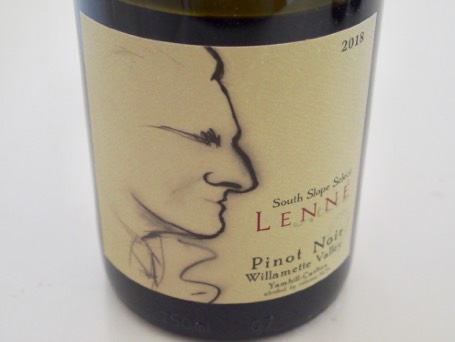 2018 Lenné Estate South Slope Select Yamhill-Carlton Willamette Valley Pinot Noir Slope Select Yamhill-Carlton Willamette Valley Pinot Noir 14.1% alc., pH 3.81, TA 0.59, 150 cases, $55. Released 9/1/20. 80% Pommard and 20% 115 clones. 100% de-stemmed followed by a 5-day cold soak prior to inoculation. Aged 11 months in French oak barrels, 20% new. · Moderately dark garnet color in the glass. This beauty made me sit up in my chair. Lively aromas of cherry, blueberry and baking spices. Impressive attack and mid-palate length with delicious flavors of black cherry, ripe strawberry and spice. The fruit has energy and elevated status. Commendable harmony with integrated tannins and inviting shafts of acidity, finishing strong and persistent. More forward when tasted the following day from a previously opened bottle. The wine can be enjoyed now but would benefit from decanting or cellaring a few years. Score: 94
2018 Lenné Estate Cinq Elus Yamhill-Carlton Willamette Valley Pinot Noir 14.1% alc., pH 3.79, TA 0.58, 125 cases, $78. Released 9/1/20. The name, cinq élus, means ’five select’ and is a blending of the single best barrel of all five of the Pinot Noir clones planted in the Estate Vineyard. This is the winery’s finest wine and is only produced in exceptional vintages. Steve recommends a minimum of six years of aging as this wine will take longer than the other wines to evolve.. 100% de-stemmed, 5-day cold soak, aged 11 months in French oak barrels, 80% new. · Dark garnet color in the glass. The nose evolves slowly in the glass to reveal aromas of black cherry, cassis and baking spices. Reclusive on first approach, grudgingly revealing mid-weight plus flavors of blackest cherry, black raspberry and purple berries with an interesting riff of Mexican hot chocolate. Redeeming balance with of grip of tannin to insure age ability. More giving and luscious when tasted the following day from a previously opened bottle, displaying the longest finish of all of the 2018 offerings. I have to give this wine extra credit for potential as it is currently tight. Cellar for six years for the full experience. Score: 95
Broadley Vineyards
Like many Californians who pioneered the Oregon wine industry, Craig and Claudia left Berkeley, California for Oregon in search of a proper site to plant Pinot Noir in the Willamette Valley. They found their ideal location in the southern part of the Willamette Valley AVA just outside of the small town of Monroe, just over an hour’s drive south of McMinnville. Monroe is referred to as the ‘banana belt’ of the Willamette Valley because it is the warmest and driest part of the AVA. The success of Broadley Vineyards has come virtue of its unique, solitary, yet strategic location the skill of second-generation winemaker Morgan Broadley, and the resultant wines that are individualistic for Oregon. Because of the vineyard’s southern Willamette Valley location, Pinot Noir vines do not struggle to achieve ripeness and stem lignification is more commonplace. As a result, Broadley Vineyard’s signature style is based on the use of a high percentage of whole cluster during fermentation in wooden puncheons of various sizes. Aging is typically carried out in 20%-30% new French oak barrels. Morgan is pictured below in 2017 at the winery with his two daughters (wooden fermentation tanks in the background).
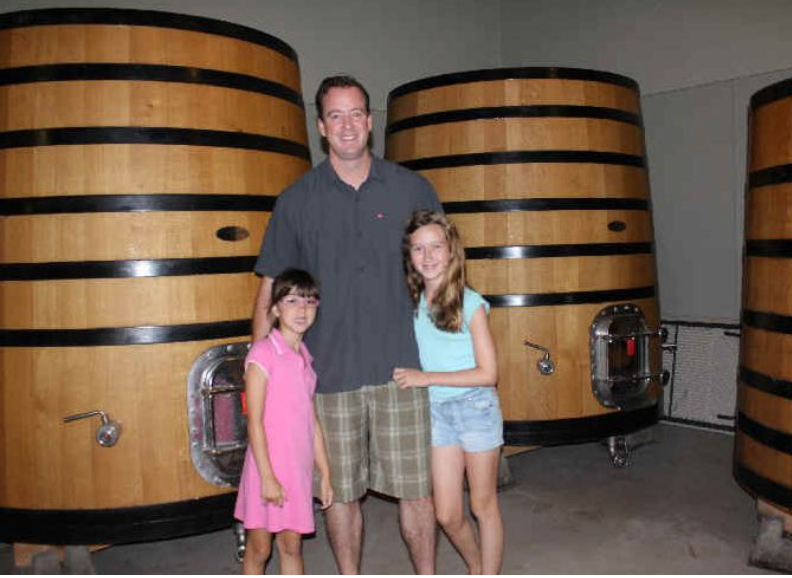 The majority of the Pinot Noir bottlings are sourced from the Estate Vineyard but other notable vineyards in the Willamette Valley have been included in some bottlings such as Shea, Zenith, Saffron Fields, Open Claim and Temperance Hill. Total production is about 5,000 cases and includes a Chardonnay made from grapes sourced from the Eola-Amity Hills. Tasting is by appointment at the winery. A majority of the winery’s Pinot Noir bottlings are sold through a mailing list or the winery’s online store at www.broadleyvineyards.com. Cellar releases from previous vintages are offered. A “When to Drink” section is a valuable reference.
2018 Broadley Vineyards Estate Willamette Valley Pinot Noir 13.9% alc., 1,300 cases, $35. Released November 2019. Pommard, 115, 667 and 777 clones. 15% whole cluster, wild yeast fermentation. Split into open-top stainless steel fermenters for 14-21 days. Aged 12 months in French oak barrels, 10% new. · Dark garnet color in the glass. A complex nose unfolds with aromas of blackberry, cassis, damp earth and cardamom spice. Somewhat rich and plush on the palate but energetic in a mid-weight style featuring purple and blackberry flavors with a hint of black tea. Nicely balanced with some finishing generosity. Overdelivers for the price. Score: 92
2018 Broadley Vineyards Claudia’s Choice Willamette Valley Pinot Noir 13.8% alc., 225 cases, $55. Released spring 2020. Named for Broadley Vineyards co-founder Claudia Broadley. A blend of Pommard and Wädenswil clones with the majority Pommard. 40% whole cluster, wild yeast fermentation in open-top French oak fermenters. Aged 14-18 months in French oak barrels, 30% new. · Dark garnet color in the glass. The nose gains traction over time in the glass, revealing aromas of spiced black cherry and dried herbs. There are many layers of flavor and noticeable length on the mid palate along with a full mouthfeel. Middleweight in style, with black cherry and boysenberry fruits framed by moderately husky, dusty tannins. The tasteful fruit core makes an impression and is complimented by a touch of oak. Still alluring when tasted the following day from a previously opened bottle. Score: 93
2018 Broadley Vineyards Jessica Willamette Valley Pinot Noir 13.8% alc., 200 cases, $55. Released spring 2020. Named for Morgan Broadley’s wife and working partner in Broadley Vineyards. 100% Wädenswil. 50% whole cluster wild yeast fermentation in French open-top wood fermenters. Aged 14-18 months in French oak barrels, 30% new. · Moderately dark garnet color in the glass. The dark-fruited nose is annotated with aromas of dark rose petal, forest and underbrush. More noticeably whole cluster driven in a mid-weight plus style, with flavors of blackberry and black raspberry. Evident but not intrusive tannins provide a suitable backing for the fruit load. More giving when tasted the following day from a previously opened and re-corked bottle. Score: 93
2018 Broadley Vineyards Marcile Lorraine Willamette Valley Pinot Noir 13.8% alc., 125 cases, $55. Released spring 2020. Named for Craig Broadley’s (co-founder) mother. A blend of Dijon 115 and Pommard clones. 50% whole cluster, wild yeast fermentation in open-top French oak fermenters. Aged 14-18 months in French oak barrels, 30% new. · Moderately dark garnet color in the glass. The nose offers clean and alluring scents including blackest cherry, pomegranate and vanilla. A bit lighter on its feet than the other 2018 offerings but with charming, well-spiced, red and black cherry fruit flavors matched to focused tannins. The incredibly long finish seems to last over 30 seconds. Score: 94
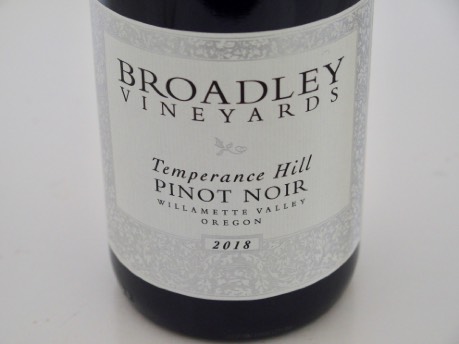 2018 Broadley Vineyards Temperance Hill Vineyard Eola- Amity Hills Willamette Valley Pinot Noir 13.9% alc., 72 cases, $55. Released November 2019.Temperance Hill is a certified organic vineyard planted in 1981 by the Koo family and managed by Dai Crisp since 1999. Soils are predominantly Nekia, Rittner and Jory. Pommard clone. 70% whole cluster, wild yeast fermentation in open-top French oak fermenters. Aged 12 months in French oak barrels, 30% new. · Dark garnet color in the glass. Inviting aromas of blackberry, cherry cola, burnt tobacco and a hint of vanilla. Beautifully crafted in a midweight style with nicely-ripened and exuberant flavors of blackberry and black raspberry. The fruit in this wine really sings. Well-mannered tannins provide good structure and the uplifting acidity brings juiciness. The finish is remarkably long and satisfying. Flat-out terrific when tasted the following day from a previously opened and re-corked bottle with even better integration of tannins. A special wine that will benefit from cellaring. Score: 95
Wine News Tidbits
Shadows in the Vineyard to be the Plot for a Television Wine Drama In December 2016 I recommended the book, Shadows in the Vineyard: The True Story of the Plot to Poison the World’s Greatest Wine. The true story by Maxmillian Potter revolves around a sinister plot to poison vines in the grand cru monopole, Romanée-Conti Vineyard, for a 1 million euro ransom in 2010. Film companies were to start production in Europe in early 2021 with actors Judith Light and Noah Wyle to star and produce. Wine Docuseries CRUSH Premieres on SOMM TV CRUSH is a SOMM TV series created by a trio of women. The series premiered on Friday, December 18, with an episode on the production of wine from grape harvest to bottle in California’s Sonoma County during the fall of 2020. The featured winery is Flambeaux Wine in Dry Creek. SOMM TV is a subscription on-demand streaming platform ($49.99 for a year) and podcast network (free) centered on wine, food, and travel and is meant to be educational. SOMM TV is available on every device and smart TV through a custom app and website at www.SommTV.com. Best Method for Cleaning Wine Glasses Tasting for wine reviews necessitates cleaning a lot of wine glasses and I want them to be pristine before reuse. My son, Dane, who works at Ashes & Diamonds Winery in Napa Valley sent me a Riedel Microfibre Polishing Cloth and I found that using it to polish wine glasses after a gentle wash led to a sparkling clean shine. As Riedel points out, the cloth removes grease and polishes without leaving behind any streaks or lint. The cloth can be washed after use (without fabric softener). The cloth is available on Amazon for $13.99.
 Iowa State University Research Study on Diet and Cognitive Acuity In November 2020 issue of the Journal of Alzheimer's Disease, a study is reported that connects specific foods to later-in-life cognitive acuity. The study found that cheese, by far, was shown to be the most protective food against age-related cognitive problems, even late in life. Daily consumption of alcohol, particularly red wine, was related to improvements in cognitive function as well. Weekly consumption of lamb, but not other red meats improved long-term cognitive function. Excessive consumption of salt had a negative effect. Conclusion: Adding cheese and red wine to the diet daily, and lamb on a weekly basis may improve long-term cognitive outcomes. Bacigalupi Vineyards “Renouveau” Chardonnay The Chardonnay grapes planted at Bacigalupi Vineyard in 1964 played an important role in the 1976 Paris Tasting. 40 percent of the grapes in the “Napa Valley” Chateau Montelena Chardonnay that beat the French white Burgundies in a blind tasting were sourced from the Russian River Valley Bacigalupi Vineyard. After the Paris Tasting, the amount of Chardonnay planted and produced in California grew by more than 400 percent. It has been more than 40 years since the Paris Tasting and Bacigalupi Vineyards is releasing a 2018 “Renouveau” Russian River Valley Chardonnay from this same small planting of Chardonnay grapes. For the last 22 vintages, the Old Wente Chardonnay grapes were committed to another winery but in 2018 the grapes became available and the Bacigalupi's decided to keep it for the family. 100 cases of this wine were produced in 2018 ($82). Visit www.bacigalupivineyards.com. Vintec Wine Cabinets I recently discovered wine cabinets that are manufactured in Denmark for the North American market. These free-standing or built-in climate-controlled cabinets have tailored shelving to accommodate all sizes of wine bottles. The Vintec wine cabinets are equipped with an efficient air circulation system and a powerful air filter to ensure a constant, slow flow of filtered air throughout the cabinet to preserve the integrity of labels and corks and keep the wines protected from odors penetrating the wine. The cabinets have UV-resistant tinted and insulated glass doors, and UV-free LED lighting. Hygrometry levels are maintained over 50% to preserve corks and prevent wine from oxidizing while cellaring. Vintec wine cabinets are available throughout the United States. Visit www.vintec.com. New Federal Government Guidelines for 2020-2025 Leave Alcohol Limits Unchanged The scientific committee had recommended lowering the limit for alcoholic beverages for men to one drink a day from two, matching the existing guidance for women. The dietary guidelines, just released, are updated every five years and recommend no more than two standard drinks (a standard drink of wine in the US is 5 ounces) a day for men and one standard drink for women. I applaud the U.S. Departments of Agriculture and Health and Human Services for maintaining the long-standing definition of moderate alcohol consumption. The new guidelines recommend following a healthy dietary pattern that consists primarily of vegetables, fruits, whole grains, lean meat and poultry, low-fat dairy, seafood, nuts and vegetable oils. They also advised limiting added sugars, saturated fats, sodium and alcoholic drinks. What 5 ounces of wine (one drink) really looks like in different glasses:
|
